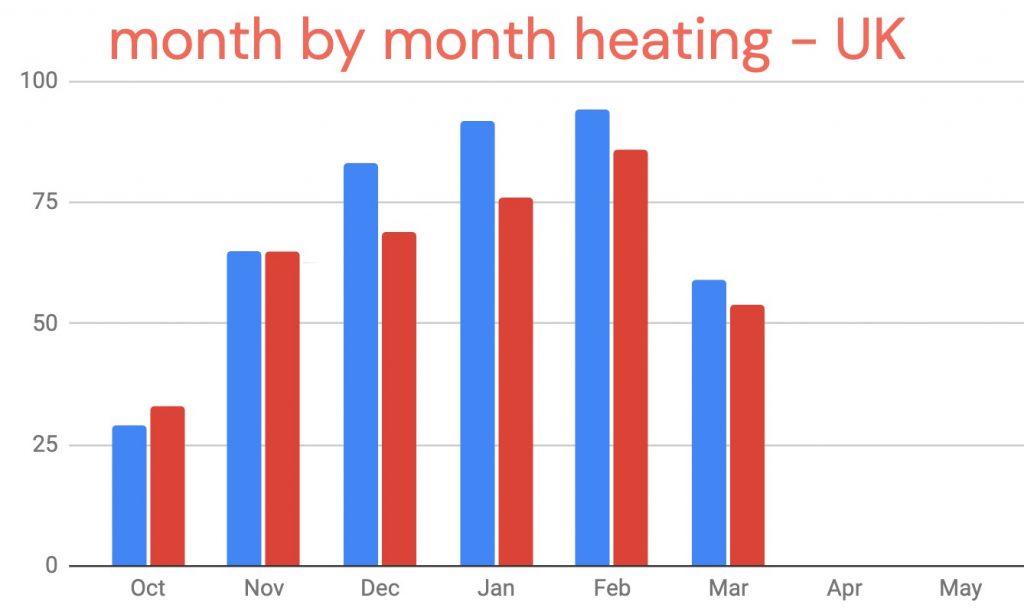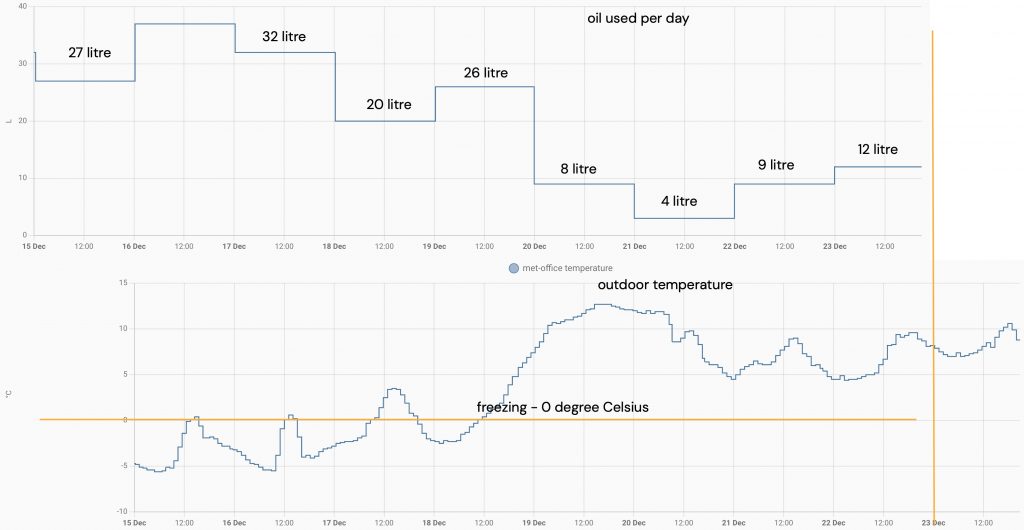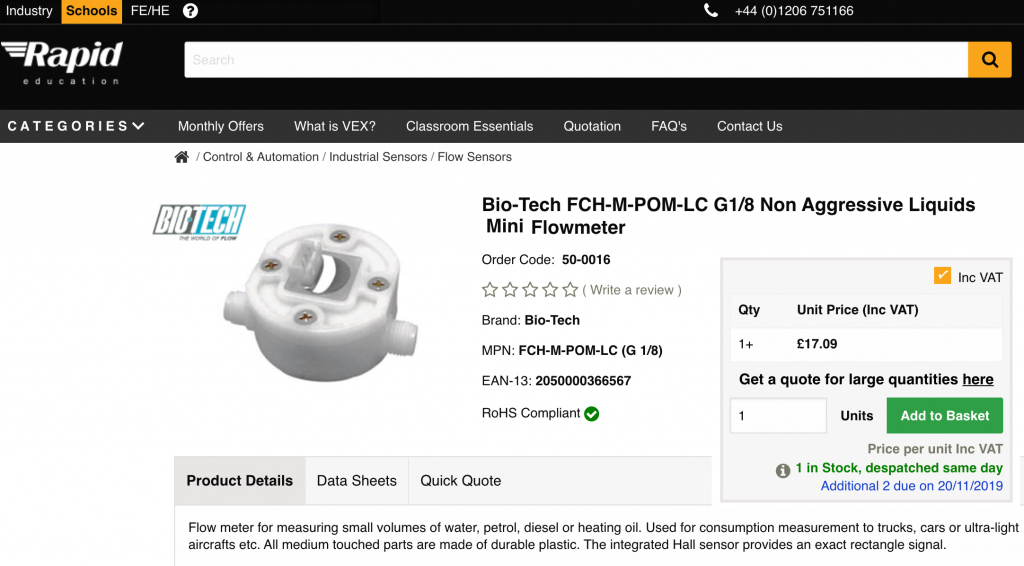how much heating oil does the boiler use?
how much heating oil ought I use each year?
Of course it depends but 1000 to 1500 litres a year is a useful figure. Let start with an example (which you can improve on by doing your own survey to find your kWh/square meter heating cost).
A bungalow with 60 sq m of floor area was said to need 150 kWh/sqm (based on room volumes, how much window, how many exterior walls and how much insulation there is. The figure is unique to the property). This comes to 6200 kWh for six months of space heating and 2400 kWh for 12 months of water heating. Adding that up gives us 8600 kWh divided by 9 kWh per litre of oil = 950 litres a year. (If the heating boiler is only 90% efficient then the amount of oil used in a year could be 1050 litres a year). During winter 20% of this oil usage seems to involve heating water for baths and so on.
how much heating oil might I use month by month?
On average 150 to 200 litres a month (based on 1050 litres per annum). This depends on the climate and my figures show that we only require heat in six months of the year. Of the six months, four months have larger bills with January and February leading to the largest bills.

how much heating oil do I use in a day / hour?
The rough answer for a domestic central central heating boiler is 1.5 litres to 2.5 litres an hour if it’s continuously alive and burning oil. If heating oil costs £1 per litre then your boiler is costing you £1.50 to £2.50 per hour. In reality the boiler is using half of this because the boiler stops running when the system gets up to temperature. If I watch my boiler, it’s active for 40% to 60% of the time. In the coldest months the boiler is active more than 80% of the time. (I know this because a nest thermostat tells me the number of scheduled hours while an hour meter tells me the burning oil hours).
Do your own calculation: find how many hours of heating you’ve programmed into your boiler. If you had scheduled six heating hours a day, half that to get 3 (=50% active) and multiply those 3 hours … by 1.5 litres for a flat/condo boiler or 2.5 litres for a house boiler. So the house boiler uses roughly 3 * 2.5 = 7.5 litres a day depending on weather and house insulation. Read on if you want to equip yourself to monitor your actual oil usage.
How the calculation works: the boiler spec sheet shows that a boiler nozzle size of 0.5 will lead to a certain flow rate – quoted in US gallons per minute. This calculates to a flow rate of 1.895 litres per hour in theory (in practice I showed that to be 1.6 litres an hour). If heating oil costs £1 per litre, the boiler costs 1.6 * 1 (about £1.50) to run continuously for an hour. For billing purposes, each hour the meter clocks up costs £1.50. On the coldest of days we used 30 litres of heating oil. That’s 18 hours of burning time in 24 hours. The graph shows a rough correlation between outdoor temperature and how much we turned up the heating. (I suspect it would correlate exactly if we hadn’t manually adjusted it during a cold spell.

how to monitor your heating oil use in a day
Background: my central heating boiler burns ‘heating oil’ kept in a tank in the garden – we do this here because we have no access to the ‘natural gas’ that’s piped around the UK. Oil is 25% more expensive than gas. As there are two households drawing oil from the same tank I was keen to find a way to divide up the bill for our use of fuel. While your need will be different an oil meter can measure your oil use and help with budgeting or knowing when you’ll need to order oil.
My need was to meter the use of oil for billing purposes and I met that easily and inexpensively as described below. (You might care to see my display of how much energy is used. Or you might like my device that measures the oil level in the supply tank and shows me the oil usage in Home Assistant).
Is there a sensor to show much oil is used by a boiler? Well, a diesel oil flow meter needs to measure from 3 litres an hour up to 20 litres a day. But I found oil flow sensors that measure 100 litres a minute and that’s too much. The mini flowmeter at Rapid (below) could measure slow oil consumption. Another, from Adafruit might be ideal – but its accuracy is only 10%. However I was hesitant to put a device into the fuel line that might one cause the boiler to fail. So I changed tack …


My solution (from 2016) is a 240v hour meter. It’s a part you’d find on a machine where it would count the time until a service was required. This timer is mechanical so it doesn’t reset if the power fails. I got the boiler service man to wire the meter in parallel with the heating circuit so that the meter would only count the hours when the boiler was burning oil. You don’t want the meter to count hours when the boiler was simply ‘on’ as set by the heating programmer. The meter cost £5 – which is a more appropriate price than paying up to £150 for an oil flow meter.
It’s now 2022 and I’m looking for a version of this sensor which works with Home Assistant – it needs to monitor is how long a circuit stays active while unfailingly allowing the boiler to work.


How is the oil meter calibrated?
The meter measures burning hours, and if we know the oil nozzle flow rate, we can turn that into litres. My calculation goes like this for two almost identical boilers:
The boiler spec sheet shows that a boiler nozzle size of 0.5 will lead to a certain flow rate – quoted in US gallons per minute. Nominally that is 1.895 litres per hour but further study showed that to be 1.6 litres an hour. If heating oil costs £1 per litre, the boiler costs 1.6 * 1 (about £1.50) to run continuously for an hour. For billing purposes, each hour the meter clocks up costs £1.50.
Given the above, verified by how much the oil level dropped over several days, I concluded that here was a way to apportion the cost of heating oil between the two households. I’m using the ratio of working hours towards dividing up the cost of the last tankful of oil.
It’s interesting to know that there are measuring devices that can be used in order to keep track of heating oil consumption. That would help in supplementing a heating oil delivery services for sure. Getting to optimize the heating at home would surely make the winter be more comfortable especially that I plan to stay home for the holidays this year.
We’ve recently moved into a state where winter is harsher than where we came from. So, we are looking into how heating oil is used for the boiler. It’s good to know that we could use something like a diesel flow meter and it needs to be specifically chosen according to the necessity.
Thanks for writing in. I find using oil to heat is inconvenient compared to piped gas or electricity. But in some places that’s what we use.
A diesel flow meter might be the first idea – I use the hour meter shown instead. Frankly we more need to know how much diesel oil you have left in the tank. That’s what the very successful tank level sensor achieves at https://www.rogerfrost.com/oil-tank-level-sensor-also-water-softener-salt-level/
Well done. Using the hour meter is what I’ve been doing since 2013. I know how many hours running time I can get out of 1000 litres (426).
Well done for finding that figure. (And you beat my installation by 3 years). In summary then:
Your place 426 hours from 1000l
the flat boiler 527 hours from 1000l. That’s 44 days oil burning at 6 hours a day – a bit of a guess
my house boiler 310 hours from 1000l. That’s 26 days oil burning at 6 hours a day
The oil level meter is most useful for knowing when to order more oil. https://www.rogerfrost.com/oil-tank-level-sensor-also-water-softener-salt-level/
I’ve recently started measuring oil consumption by having a raspberry pi (and USB mini microphone) listen for the boiler – it then records the start and stop time to a cloud spreadsheet from which I calculate the consumption using the nozzle size.
Works well!
Thank you.
For want of a word, that is a gorgeous approach that has no equal. And gosh the maths. Your results are welcome here.